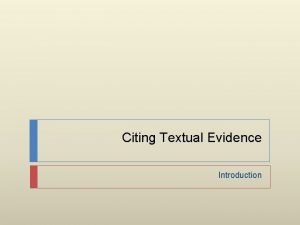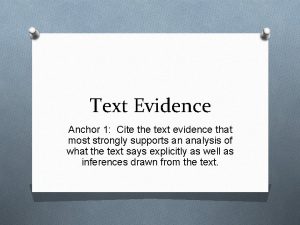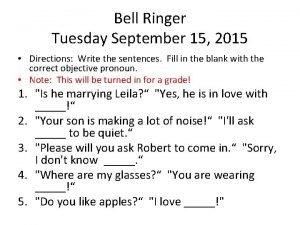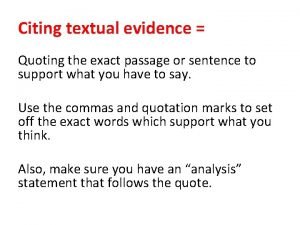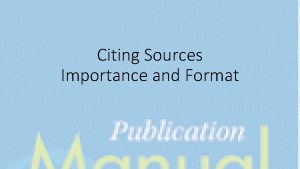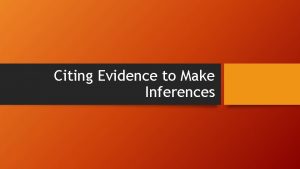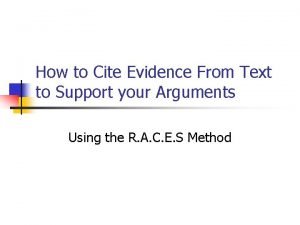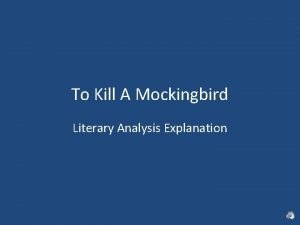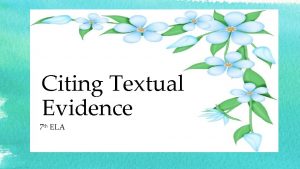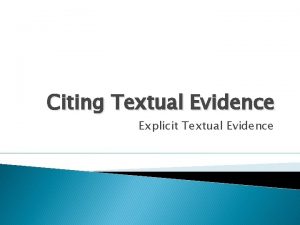Citing Textual Evidence Introduction What is text evidence










- Slides: 10

Citing Textual Evidence Introduction

What is text evidence? � This means any information you take from the text (article, essay, chart, film, speech, etc. )

Can I simply take text evidence and use it as my own? � No! If you do, it is called plagiarism or stealing.

Then how can I use it? � Simple, all you need to do is cite the source. In other words, give credit to the original author. � Directly after the piece you borrowed, place the author’s last name in parenthesis followed by the page number it was on. (Johnson, 3).

Now that we know how to cite text evidence, let’s discuss how to write it. � Always start by introducing your text evidence with what we call a lead or sentence starter. This makes it clear to readers they are about to learn someone else’s thoughts. � There are many different leads you can use or alter: According to the author, _____ The article describes, ____ For example, _____

Now what? � Once you have your lead, you can either pull text evidence word for word from the passage or paraphrase it. q Word for word: � Place the evidence in quotation marks indicating it is exactly what the original text said. According to the story, “Stephanie hated watching scary movies” (Jones, 4). § q Notice how the final end mark goes after the citation. Paraphrased: � Using your own words, write what the original text said without using quotation marks. According to the story, Stephanie didn’t enjoy horror movies (Jones, 4).

Leads -On page ___, it explained, _____. -The author wrote, ______. -In the text it described, _____. -According to the text, _____. -From the reading one can learn, ____. -According to the article "___" by ___, ______. -An example is, ______. -For instance, _______. -For example, _______. -In the film, ______. -During the speech, he/she mentioned, ______.

Let’s Practice! � Which sentence is a correct example of text evidence? � A. “Hunger is a large problem around the world” (James, 3). � B. “Hunger is a large problem around the world. ” (James, 3) � C. The author explained, “Hunger is a large problem around the world” (James, 3). � D. The author explained, “Hunger is a large problem around the world. ” (James, 3)

“Little Red Riding Hood” � 1. What is Little Red Riding Hood bringing to her grandmother? � The author wrote, "here is a piece of cake and a bottle of milk" (Grimm, 1). � 2. What type of trees is Grandmother's house under? � On page __ it describes, "____" (_____). � 3. What tool did the huntsman use to cut the wolf open? � He used a ___ because the text stated, "_____" (____).

(Cont. ) � 4. What three physical features does Little Red Riding Hood question her "grandmother" about? � On page ___, Little Red asks the wolf about _____ (_____). � 5. Why does the huntsman go to the house? � The text explains a _____ was heard by ______ which caused him to ______ (_____).
 Cite text evidence
Cite text evidence Iep goal for citing textual evidence
Iep goal for citing textual evidence Mla format citing textual evidence
Mla format citing textual evidence Citing sources sentence starters
Citing sources sentence starters Citing text evidence sentence starters
Citing text evidence sentence starters Citing evidence examples
Citing evidence examples Importance of citing evidence
Importance of citing evidence Citing evidence to make inferences
Citing evidence to make inferences Citing evidence sentence starters
Citing evidence sentence starters Text to text text to self text to world
Text to text text to self text to world To kill a mockingbird literary analysis
To kill a mockingbird literary analysis
